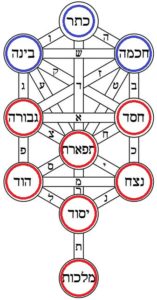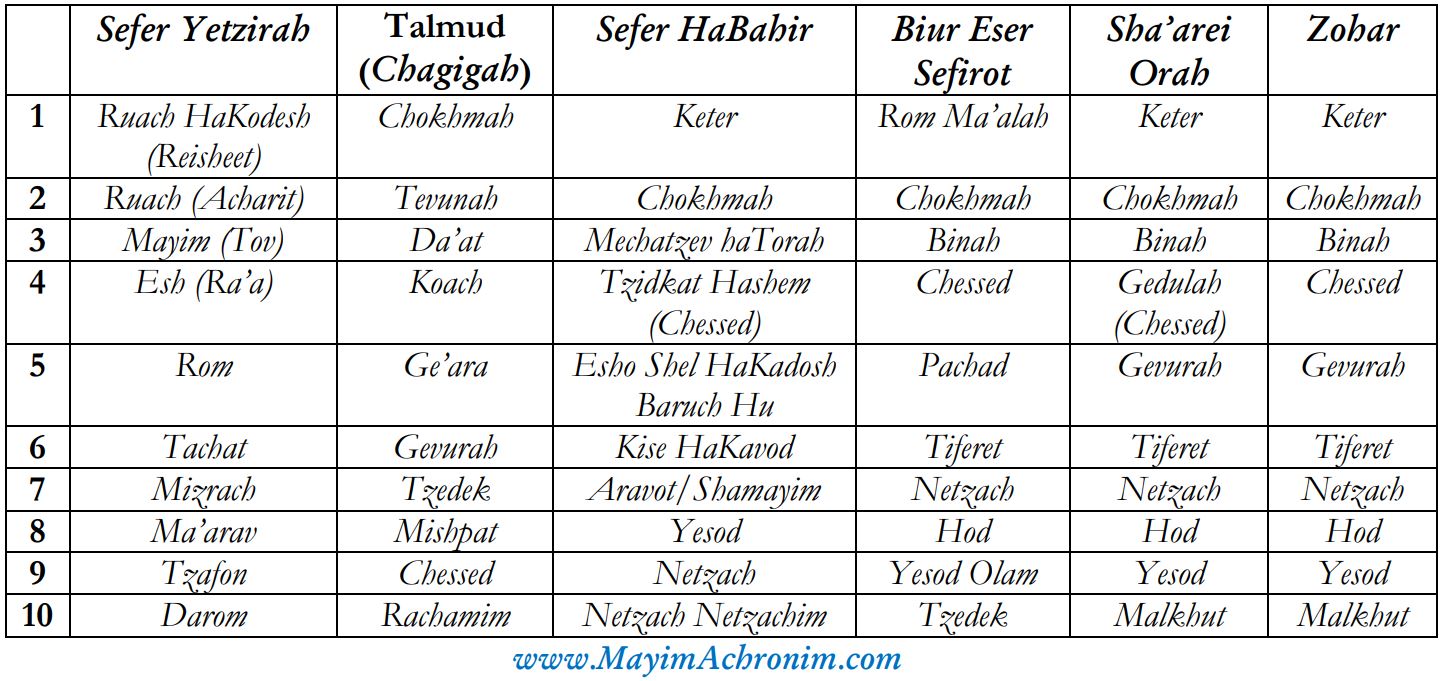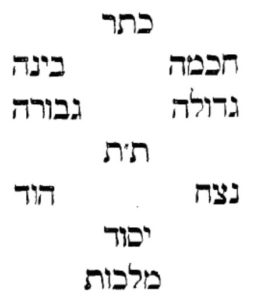
The Sefirot of mochin above (in blue) and the Sefirot of the middot below (in red) on the mystical “Tree of Life”.
This week, in parashat Yitro, we read the Ten Commandments. As with all other things that are ten in the Torah, the Ten Commandments correspond neatly to the Ten Sefirot. Just as the first three of the Sefirot are on a higher plane, referred as the mochin, the first three of the Commandments are also distinct and relate directly to God (to know there is a God, to have no other gods or idols, and not to take God’s Name in vain). We saw a similar division of ten into groups of three and seven in the Ten Plagues, where the first seven are read in parashat Va’era, and the final three in parashat Bo. Likewise, we find a division of ten into three and seven in the very first case of ten: the Ten Utterances of Creation.
As our Sages famously teach, God created the entire universe through Ten Utterances (Avot 5:1). When we look in the first chapter of Genesis at the account of Creation, we find the expression “And God said” exactly 10 times. It was through these Ten Utterances that God brought the entire cosmos into existence. It is important to note that the last instance of “And God said” (1:29) is really just a continuation of the ninth instance (1:28). The actual remaining Utterance is the first word of the Torah: Beresheet. This word itself was the First Utterance, and was the initial burst of energy that brought a dark universe into existence. The Second Utterance was “Let there be light”, and the Third was “Let there be a firmament”. While the first three clearly involve grand cosmic developments, the remaining seven Utterances all relate specifically to Earth.
Of course, all of the above tens correspond to the Ten Sefirot, the first emanations that emerged out of God’s Infinite Ein Sof. The Ten Sefirot permeate all of existence, which is why we find so many patterns of ten in the Torah and all around us in Creation. The notion of Ten Sefirot is a foundational and inseparable part of Judaism, yet few are aware of where all the information about the Sefirot came from! It is commonly thought that the Sefirot were first revealed by the Zohar, but this is highly inaccurate. Discussion of the Sefirot dates back centuries before the first publication of the Zohar. So, let’s take a brief trip back in time to explore the historical revelation of the Sefirot.
Sefer Yetzirah
Possibly the oldest known text to discuss the Ten Sefirot is the ancient Sefer Yetzirah. Its teachings are attributed to none other than Abraham, the first patriarch. Based on an analysis of its language, it is quite likely that it was first recorded and published around the same time as the Mishnah, and possibly even earlier to the end of the Second Temple era. It is already mentioned in the Talmud (Sanhedrin 65b).
Sefer Yetzirah begins by outlining the 32 Paths of Wisdom, corresponding to the 32 times that God is mentioned in the account of Creation. Here we find for the first time a clear reference to the teaching that the Ten Utterances parallel the Ten Sefirot. Having said that, we do not find in Sefer Yetzirah any of the names of the Sefirot with which we are familiar today (such as Chessed and Gevurah). Instead, we are first told that the Ten Sefirot correspond to the ten fingers of the hand (1:2), and then that we should understand them deeply (1:3), before being given a list of the Ten Sefirot as follows: “Beginning and End, Good and Evil, Up and Down, East and West, North and South.” (1:4)
Sefer Yetzirah then gives further explanation, saying that the first Sefirah is Ruach HaKodesh, the “Holy Spirit” of God. Out of this spirit emerges the next Sefirah, the physical “wind”, Ruach, or air. Out of air comes “water”, Mayim, from which emerges Esh, “fire”. Now that we have these primordial elements, the next six Sefirot are the ketzavot, the six directions of up, down, east, west, north, south. This ends the first chapter of Sefer Yetzirah, and the second begins by elucidating the 22 holy letters of the Hebrew alphabet.
In short, Sefer Yetzirah explains that God created the entire three-dimensional cosmos with six directions of space, filled it with His Spirit, from which He first created the primordial elements, from which everything else was then generated. Here, the Ten Sefirot correspond to space, spirit, and the primordial elements of Creation.
Talmud in Chagigah
It may come as a surprise to some that the Talmud actually does speak of the Ten Sefirot in cryptic fashion. It is found in one of the most esoteric sections of the Talmud, in tractate Chagigah (12a). Here is where we also find the famous story of the “Four Who Entered Pardes”, a cautionary tale about delving too intensely into mystical matters. The Talmud is the first to reveal some of the actual names of the Sefirot. While the Mishnah has already told us that God created with Ten Utterances, here in the Talmud we get a lot more detail, with links to sources directly from the Torah:
With ten things was the world created: With wisdom [Chokhmah], and with understanding [Tevunah], and with knowledge [Da’at], and with strength [Koach], and with rebuke [Ge’ara], and with might [Gevurah], with righteousness [Tzedek] and with judgment [Mishpat], with lovingkindness [Chessed] and with compassion [Rachamim].
With wisdom and understanding, for it is written: “God founded the earth with wisdom; and with understanding He established the Heavens.” [Proverbs 3:19] With knowledge, for it is written: “With His knowledge, the depths were broken up…” [Proverbs 3:20] With strength and might, for it is written: Who by His strength set the mountains firmly, Who is girded with might.” [Psalms 65:6] With rebuke, for it is written: “The pillars of Heaven were trembling, astonished at His rebuke.” [Job 26:11] With righteousness and judgment, for it is written: “Righteousness and judgment are the foundation of Your throne.” [Psalms 89:15] With lovingkindness and compassion, for it is written: “Remember, God, Your compassions and Your kindnesses; for they have been of old.” [Psalms 25:6]
It is quite simple to parallel this list in the Talmud with the Sefirot as we know them: Chokhmah, Binah (or Tevunah), and Da’at are clear, as are Gevurah, Chessed, and Rachamim (ie. Tiferet). Koach and Ge’ara can be paralleled to Netzach and Hod, while Tzedek and Mishpat relate to Yesod and Malkhut, as we shall soon see.
Sefer HaBahir
The next major text to explore the Ten Sefirot is another ancient mystical book, Sefer HaBahir, the “Book of Illumination”. It may be as old as Sefer Yetzirah, and is generally attributed to Rabbi Nehuniah ben HaKanah, who lived at the end of the Second Temple era. Sefer HaBahir was officially first published in the late 12th century, possibly by Itzchak Sagi Nehor (“Isaac the Blind”, c. 1160-1235). It is in Sefer HaBahir where we are told that the first Sefirah is called Keter. The second is Chokhmah, while the third is referred to as Mechatzev haTorah, literally a “quarry” from which wisdom is extracted. The latter is undoubtedly the equivalent of Binah, with deeper understanding compared to the act of “chiseling” and refining a rough block of knowledge. The fourth is Tzidkat Hashem, the “charity of God”, and His Chessed. The fifth is referred to only as the “fire of the Holy One”, His “left hand” and the place of the fiery angels. The sixth is God’s “Throne of Glory” in which the divine Light of Creation, the Ohr haGanuz, is concealed.
Following this, the Bahir gets a little convoluted (see Ch. 153, et seq.). There are multiple ways to understand its language, the simplest being that the seventh Sefirah is called Aravot or Shamayim, “Heavens”; the eighth is Yesod; the ninth is Netzach (associated with the Ofanim), and the tenth is Netzach Netzachim. Significantly, here we see a discussion of the place of circumcision as it relates to the eighth, Yesod. The later Kabbalists would have much to say about Yesod and Tikkun haBrit—the guarding and rectifying of one’s “covenant”. It is also worth mentioning how the Bahir explains the root of the word “Sefirah”: According to the Bahir, the word comes from Psalms 19:2, that “The Heavens describe [mesaprim] the glory of God…” In other words, “Sefirah” comes from the root lesaper, meaning “to relate” or “to describe”. The point of the Sefirot is to reveal and relate deeper information about God’s Creation.
Biur Eser Sefirot
The Bahir was first published by one of the great early mystical circles in the south of France and north of Spain. Among the key members of this circle was Rabbi Azriel ibn Menachem al-Taras of Gerona (c. 1160-1238), who was actually a student of Isaac the Blind. Rabbi Azriel put together a short text called Biur Eser Sefirot, “Explanation of the Ten Sefirot”, also known as Sha’ar HaShoel, “Gate of the Enquirer”. It is a wonderful step-by-step guide, written clearly and concisely, through a set of sequential questions (it can be accessed here).
At the time, discussion of the Ten Sefirot was only just beginning to enter the public discourse, so it was necessary to explain what these Sefirot are, and why they are in no way contradictory to the notion of monotheism. In fact, Rabbi Azriel makes it clear that a monotheist really has to accept the Sefirot, for otherwise there is no way to explain how an infinite, perfect, ethereal God could produce a finite, imperfect, physical dimension of all kinds of disparate elements. The Sefirot serve as the interface between the singular Ein Sof and our seemingly diffuse and diverse reality.
In Biur Eser Sefirot, Rabbi Azriel gives us the names of the Sefirot as follows: Rom Ma’alah, Chokhmah, Binah, Chessed, Pachad, Tiferet, Netzach, Hod, Tzadik Yesod Olam, and Tzedek. Rabbi Azriel goes on to group them, with the first three being related to sekhel, “the intellect”, ie. the mochin. The next three he relates to the realm of nefesh, “soul”. The final four are related mostly to the guf, “body”. Rabbi Azriel then explains the power of each one: the first is divine, the second is angelic, the third is prophetic. The fourth is kindness while the fifth is judgement. The sixth is rachamim, “compassion”, as expected. The seventh is in order to strengthen the soul, while the eighth appears to be to weaken it, and the ninth channels all the others. The tenth is also referred to as “judgement”, here in the lower realms.
Finally, Rabbi Azriel relates the Sefirot to the various souls and parts of the body, though differently from what we might expect: The first Sefirah of Rom Ma’alah corresponds to the highest level of soul, the Yechidah. Next, Chokhmah corresponds to Chayah, and Binah to Ruach. Chessed is Nefesh, while Gevurah/Pachad is Neshamah! Tiferet is the blood, Netzach is the bones, Hod is the flesh, Yesod is the nerves, and Tzedek is the skin.
Sha’arei Orah and Zohar
One of the great mystics who was influenced by the Kabbalistic schools of southern France and northern Spain was Rabbi Avraham Abulafia (c. 1240-1291). He considered himself a prophet and even thought he might be Mashiach, which didn’t make him especially popular. One of his students, though, would find a lot more recognition, Rabbi Yosef Chiquitilla (usually misspelled as “Gikatilla”, c. 1248-1305). He composed one of the first proper Kabbalistic manuals, called Sha’arei Orah. The Arizal would later consider it standard reading and a must for any aspiring mystic. Sha’arei Orah goes into great depth exploring the Ten Sefirot, and tying them to the ten major names of God that appear in the Tanakh. God’s varying “names” refer to His different manifestations, which then relates directly to the Ten Sefirot, the channels through which we can come to know God and His Creation.
It is in Sha’arei Orah that we finally see the exact array of Sefirot as we know them today. Rabbi Chiquitilla even provides the famous “Tree of Life” diagram of the Sefirot, and refers to it as an ilan, “tree”. Though he may have been the first to put this image together in print, others credit Isaac the Blind, or even his father Rabbi Avraham ben David (the Raavad, c. 1125-1198). Note that Rabbi Chiquitilla also refers to Chessed as Gedulah, which is how it is called in I Chronicles 29:11, one of the key Biblical sources for the Sefirot.
Rabbi Chiquitilla was a contemporary of Rabbi Moshe de Leon (c. 1240-1305), who was the first to publish the Zohar. It is likely that the two were part of the same Kabbalistic circle of mystics in Spain, and it isn’t exactly clear whether it was the Zohar or Sha’arei Orah that was put in print first. (It is generally agreed that the Zohar was first published in 1290 or 1291.) In any case, the Zohar and Sha’arei Orah present essentially identical Sefirotic systems. This system is described most succinctly in a separate Zohar work called Tikkunei HaZohar (17a), where the angel-prophet Eliyahu reveals the secret of the Sefirot to Rabbi Shimon bar Yochai and his son Rabbi Elazar, when they were hiding and learning in a cave:
Eliyahu opened and said: “Master of Worlds! You are One, but not numerically. You are higher than the high; more concealed than the concealed—no thought grasps You at all. It is You who generated ten “garments”, called by us the Ten Sefirot, by which both concealed and revealed worlds are conducted. In them You conceal Yourself from human beings, while You are the One who binds and unites them. Since You are within, whoever separates one of these ten from another—it is as if he divided You…
The “garments” are named thus: Chessed, the right arm; Gevurah, the left arm; Tiferet, the trunk of the body; Netzach and Hod, the two thighs; Yesod, the “end” of the body, the sign of the holy covenant; Malkhut, the mouth—and this is the Oral Torah. Chokhmah is the brain, inner thought. Binah is the heart, through which the heart understands. Of these two it is written, “The hidden things are for Hashem, our God…” (Deuteronomy 29:28). The highest crown of kingship is supernal Keter, of which it is said, “He declares from the beginning [reisheet] the end…” (Isaiah 46:10)
Here we come full circle, for the teachings of the Zohar date back to Rabbi Shimon bar Yochai (“Rashbi”) and his mystical fellowship. Rashbi was one of the primary students of Rabbi Akiva, who alone was able to enter Pardes in peace, and exit in peace, as per the story in Chagigah of the “Four Who Entered Pardes”. Rabbi Akiva was a contemporary of Rabbi Nehuniah ben HaKanah, and of that early generation of mystics that likely first put Sefer Yetzirah and Sefer haBahir into writing. Above, the Zohar links right back to the Sefirot as described in Sefer Yetzirah, explaining that Keter is the Reisheet (“Beginning”) that is mentioned as the first Sefirah in Sefer Yetzirah. In other words, all of the varying names and descriptions of the Sefirot we have seen are, of course, speaking of the exact same ten forces.
We have now seen how the wisdom of the Ten Sefirot was revealed little by little, one generation at a time, starting with the briefest descriptions and allusions in Sefer Yetzirah and the Mishnah, followed by a fuller description in the Talmud, before the entire system was elucidated in later mystical publications like Sha’arei Orah and the Zohar. Today, we have all the information at our fingertips to truly grasp the Sefirot and delve into their depths. The Sefirot permeate all things in existence, and all the many things that are ten in the Torah—Ten Utterances, Ten Plagues, Ten Commandments, Ten Trials, etc.—relate to the Ten Sefirot (see Sha’ar HaMitzvot on Ki Tetze). This wondrous knowledge allows us to penetrate the depths of the Torah and reveal its wonder, and to better understand every facet of the complex universe that God built.

A summary of the Sefirot from various mystical texts. Note that the Sefirot are listed here in the sequential order of their appearance in these texts, not as they truly parallel each other.



Pingback: Colours of the Sefirot | Mayim Achronim
Pingback: Practical Jewish Meditation | Mayim Achronim
Pingback: Sefer Yetzirah and the 32 Paths of Creation | Mayim Achronim